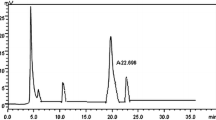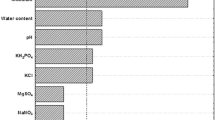Abstract
Quambalaria cyanescens was positively identified on the surface of unripened grapes by physiological and molecular techniques; this is the first work describing the isolation of this fungus in European grapes and all of them produced an exocellular β-glucosidase. Once isolates with higher activity were selected, the enzyme has been qualitatively and quantitatively determined and characterized, by spectrophotometric methods, based on its biotechnological properties Exocellular β-glucosidase produced by Q. cyanescens is inhibited by glucose but is an ethanol-tolerant enzyme and its activity is independent of the pH value. Divalent cations, mainly Ca2+, highly increase enzymatic activity. This is the first work describing the isolation, identification and characterization of Q. cyanescens in grapes. Although there is growing interest in the search for new fungal β-glucosidases, the vast majority of studies were performed with imperfect fungi, and there are scant reports that deal with basidiomycetous fungi, not only for biotechnological purposes but also for physiological research.


Similar content being viewed by others
Availability of data and materials
Not applicable.
Code availability
Not applicable.
References
Pearson RC, Goheen AC (1988) Compendium of grape diseases. APS Press, St Paul
Emmett RW, Harris AR, Taylor RH, McGechan JK (1992) Grape diseases and vineyard protection. In: Coombe BG, Dry PR (eds) Viticulture, Vol. 2: Practices. pp 242–243. Adelaide, Australia
De Beer JW, Begerow D, Bauer R, Pegg GS, Crous PW, Wingfield MJ (2006) Phylogeny of the Quambalariaceae fam. nov., including important Eucalyptus pathogens in South Africa and Australia. Stud Micol 55:289–298
Fan X, Xiao M, Kong F, Kudinha T, Wang H, Xu YC (2014) A rare fungal species, Quambalaria cyanescens, isolated from a patient after augmentation mammoplasty-environmental contaminant or pathogen? PLoS ONE 9:1–8
De Hoog GS, De Vries GA (1973) Two new species of Sporothrix and their relation to Blastobotrys nivea. Antonie Van Leeuwenhoek 39:515–520
Moore RT (1987) Micromorphology of yeasts and yeast-like fungi and its taxonomic implications. Stud Mycol 30:203–226
Sigler L, Harris JL, Dixon DM, Flis AL, Salkin IF, Kemna M, Duncan RA (1990) Microbiology and potential virulence of Sporothrix cyanescens, a fungus rarely isolated from blood and skin. J Clin Microbiol 28:1009–1115
Kolarík M, Sláviková E, Pazoutová S (2006) The taxonomic and ecological characterisation of the clinically important heterobasiodiomycete Fugomyces cyanescens and its association with bark beetles. Czech Mycol 58:81–98
Maicas S, Mateo JJ (2005) Hydrolysis of terpenyl glycosides in grape juice and other fruit juices: a review. Appl Microbiol Biotechnol 67:322–335
Sun Y, Cheng JY (2002) Hydrolysis of lignocellulosic materials for ethanol production: a review. Bioresour Technol 83:1–11
White TJ, Bruns T, Lee S, Taylor JW (1990) Amplification and direct sequencing of fungal ribosomal RNA genes for phylogenetics. In: Innis MA, Gelfand DH, Sninsky JJ, White TJ (eds) PCR Protocols: a guide to methods and applications. Academic Press Inc, New York, pp 315–322
Kurtzman CP, Robnett CJ (1998) Identification and phylogeny of ascomycetous yeast from analysis of nuclear large subunit (26S) ribosomal DNA partial sequences. Antonie Van Leeuwenhoek 73:331–371
Romero AM, Mateo JJ, Maicas S (2012) Characterization of an ethanol tolerant 1,4-β-xylosidase produced by Pichia membranifaciens. Lett Appl Microbiol 55:354–361
López MC, Mateo JJ, Maicas S (2015) Screening of β-glucosidase and β-xylosidase activities in four non-Saccharomyces yeast isolates. J Food Sci 80:1696–1704
Milanovic V, Comitini F, Ciani M (2013) Grape berry yeast communities: influence of fungicide treatments. Int J Food Microbiol 161:240–246
Ocón E, Gutiérrez AR, Garijo P, López R, Santamaría P (2010) Presence of non-Saccharomyces yeasts in cellar equipment and grape juice during harvest time. Food Microbiol 27:1023–1027
Kubátová A, Kolarík M (2007) Culture collection of fungi (CCF) in Prague original isolates accessed during. Novit Bot Univ Carol 18:91–111
Stodulková E, Císarová I, Kolarik M, Chudíckova M, Novák P, Man P, Kuzma M, Pavlú B, Cerný J, Flieger M (2015) Biologically active metabolites produced by the Basidiomycete Quambalaria cyanescens. PLoS ONE 10:1–12
Kuan CS, Yew SM, Toh YF, Chan CL, Lim SK, Lee KW, Na SL, Hoh C, Yee WY, Ng KP (2015) Identification and characterization of a rare fungus, Quambalaria cyanescens, isolated from the peritoneal fluid of a patient after nocturnal intermittent peritoneal dialysis. PLoS ONE 10:1–15
Jackson L, Klotz SA, Normand RE (1990) A pseudoepidemic of Sporothrix cyanescens pneumonia occurring during renovation of a bronchoscopy suite. J Medic Veter Mycol 28:455–459
Hernandez-Guzman A, Flores-Martıinez A, Ponce-Noyola P, Julio C, Castro V (2016) Purification and characterization of an extracellular β-glucosidase from Sporothrix schenckii. FEBS Open Bio 6:1067–1077
Sohail M, Siddiqi R, Ahmad A, Khan SA (2009) Cellulase production from Aspergillus niger MS82: effect of temperature and pH. N Biotechnol 25:437–441
Acosta-Rodriguez I, Piñon-Escobedo C, Zavala-Paamo MG, Lopez-Romero E, Cano-Camacho H (2005) Degradation of cellulose by the bean-pathogenic fungus Colletotrichum lindemuthianum. Production of extracellular cellulolytic enzymes by cellulose induction. Antonie Van Leeuwenhoek 87:301–310
Carle-Urioste JC, Escobar-Vera J, El-Gogary S, Henrique-Silva F, Torigoi E, Crivellaro O, Herrera-Estrella A, El-Dorry H (1997) Cellulase induction in Trichoderma reesei by cellulose requires its own basal expression. J Biol Chem 272:10169–10174
Vìtrovský T, Baldrian P, Gabriel J (2012) Extracellular enzymes of the white-rot fungus Fomes fomentarius and purification of 1,4-β-glucosidase. Appl Biochem Biotechnol 169:100–109
Morais H, Ramos C, Matos N, Forgacs E, Cserhati T, Almeida V et al (2002) Liquid chromatographic and electrophoretic characterisation of extracellular β-glucosidase of Pleurotus ostreatus grown in organic waste. J Chromatogr B 770:111–119
Sørensen A, Lübec PS, Teller PJ, Ahring BK (2011) β-Glucosidases from a new Aspergillus species can substitute commercial β-glucosidases for saccharification of lignocellulosic biomass. Can J Microbiol 57:638–650
Kanunfre CC, Zancan GT (1998) Physiology of exolaccase production by Telephora terrestris. FEMS Microbiol Ecol 16:151–156
Baffi M, Tobal T, Lago J, Leite R, Boscolo M, Gomes E, Da-Silva R (2011) A novel β-glucosidase from Sporiobolus pararoseus: characterization and application in winemaking. J Food Sci 76:997–1002
Manzanares P, Ramon D, Querol A (1999) Screening of non-Saccharomyces wine yeasts for the production of β-d-xylosidase activity. Intl J Food Microbiol 46:105–112
Spagna G, Barbagallo RN, Palmeri R, Restuccia C, Giudici P (2002) Properties of endogenous β-glucosidase of a Pichia anomala strain isolated from Sicilian musts and wines. Enz Microbiol Technol 31:1036–1041
Yan TR, Lin CL (1997) Purification and characterization of a glucose-tolerant β-glucosidase from Aspergillus niger CCRC 31494. Biosci Biotechnol Biochem 61:165–170
Riou C, Salmon JM, Vallier MJ, Gunata Z, Barre P (1998) Purification, characterization, and substrate specificity of a novel highly glucose-tolerant β-glucosidase from Aspergillus oryzae. Appl Environ Microbiol 64:3607–3614
Saibi W, Gargour A (2011) Purification and biochemical characterization of an atypical β-glucosidase from Stachybotrys microspore. J Mol Catal B Enzym 72:107–115
Souza FHM, Nascimento CV, Rosa JC, Masui DC, Leone FA, Jorge JA, Furriel RPM (2010) Purification and biochemical characterization of a mycelial glucose- and xylose-stimulated β-glucosidase from the thermophilic fungus Humicola insolens. Process Biochem 45:272–278
Karnchanatat A, Petsom A, Sangvanich P, Piaphukiew J, Whalley AJ, Reynolds CD, Sihanonth P (2007) Purification and biochemical characterization of an extracellular β-glucosidase from the wood-decaying fungus Daldinia eschscholzii (Ehrenb.:Fr.) Rehm. FEMS Microbiol Lett 270:162–170
Kim YA, Yoon KH (2010) Characterization of a Paenibacillus woosongensis beta–Xylosidase/alpha-Arabinofuranosidase produced by recombinant Escherichia coli. J Microbiol Biotechnol 20:1711–1716
Zhou J, Bao L, Chang L, Zhou Y, Hong L (2012) Biochemical and kinetic characterization of GH43 β-d-xylosidase/α-l-arabinofuranosidase and GH30 α–l–arabinofuranosidase/β-d-xylosidase from rumen metagenome. J Ind Microbiol Biotechnol 39:143–152
Christakopoulos P, Goodenough PW, Kekos D, Macris BJ, Claeyssens M, Bhat MK (1994) Purification and characterisation of an extracellular β-glucosidase with transglycosylation and exo-glucosidase activities from Fusarium oxysporum. Eur J Biochem 224:379–385
Yazdi MT, Khosravi AA, Nemati M, Davoodi N (2003) Purification and characterization of two intracellular β-glucosidases from the Neurospora crassa mutant cell-1. World J Microbiol Biotechnol 19:79–84
Lin J, Pillay B, Singh S (1999) Purification and biochemical characteristics of β-d-glucosidase from a thermophilic fungus, Thermomyces lanuginosus–SSBP. Biotechnol Appl Biochem 30:81–87
Wei DL, Chang TH, Lin YW, Chuang CL, Jong SC (1992) Production of cellulolytic enzymes from Xylaria and Hypoxylon species of Xylariaceae. World J Microbiol Biotech 8:141–146
Saha BC, Freer SN, Bothast RJ (1994) Production, purification and properties of a thermostable β-glucosidase from a color variant strain of Aureobasidium pullulans. Appl Environ Microbiol 10:3774–3780
Madrigal T, Maicas S, Mateo JJ (2013) Glucose and ethanol tolerant enzymes produced by Pichia (Wickerhamomyces) isolates from enological ecosystems. Am J Enol Vitic 64:126–133
Bhatia Y, Mishra S, Bisaria VS (2002) Microbial β-glucosidases: cloning, properties and applications. Crit Rev Biotechnol 22:375–407
Nguyen NP, Lee KM, Lee KM, Kim IW, Kim YS, Jeya M, Lee JK (2010) One-step purification and characterization of a beta-1,4-glucosidase from a newly isolated strain of Stereum hirsutum. Appl Microbiol Biotechnol 87:2107–2116
Yanai T, Sato M (2001) Purification and characterization of an β-d-xylosidase from Candida utilis IFO 0639. Biosci Biotechnol Biochem 65:527–533
Mateo JJ, Peris L, Ibañez C, Maicas S (2011) Characterization of glycolytic activities from non-Saccharomyces yeasts isolated from Bobal musts. J Ind Microbiol Biotechnol 38:347–354
Lenartovicz V, Marques De Souza CG, Guillen Moreira F, Peralta RM (2003) Temperature and carbon source affect the production and secretion of a thermostable β-xylosidase by Aspergillus fumigatus. Proc Biochem 38:1775–1780
Yan QJ, Wang L, Jiang ZQ, Yang SQ, Zhu HF, Li LT (2008) A xylose-tolerant β-xylosidase from Paecilomyces thermophila: characterization and its co-action with the endogenous xylanase. Bioresour Technol 99:5402–5410
Inglin M, Feinberg BA, Loewenberg JR (1980) Partial purification and characterization of a new intracellular β-glucosidase of Trichoderma reesei. Biochem J 185:515–519
Jen W, Wang W, Lin M, Lin C, Liaw Y, Chang W et al (2011) Structural and functional analysis of three β-d-glucosidases from bacterium Clostridium cellulovorans, fungus Trichoderma reesei and termite Neotermes koshunensis. J Struct Biol 173:46–56
Chen HL, Chen YC, Lu MYJ, Chang JJ, Wang HC, Ruan SK et al (2012) A highly efficient β-glucosidase from a buffalo rumen fungus Neocallimastix patriciarum W5. Biotechnol Biofuels 5:24
Funding
Not applicable.
Author information
Authors and Affiliations
Contributions
All authors contributed to the study conception and design.
Corresponding author
Ethics declarations
Conflicts of interest
No conflict of interest declared.
Compliance with ethics requirements
Our article does not contain any studies with human or animal subjects.
Additional information
Publisher's Note
Springer Nature remains neutral with regard to jurisdictional claims in published maps and institutional affiliations.
Rights and permissions
About this article
Cite this article
Mateo, J.J., Andreu, L. Characterization of an exocellular ethanol-tolerant β-glucosidase from Quambalaria cyanescens isolates from unripened grapes. Eur Food Res Technol 246, 2349–2357 (2020). https://doi.org/10.1007/s00217-020-03578-w
Received:
Revised:
Accepted:
Published:
Issue Date:
DOI: https://doi.org/10.1007/s00217-020-03578-w






